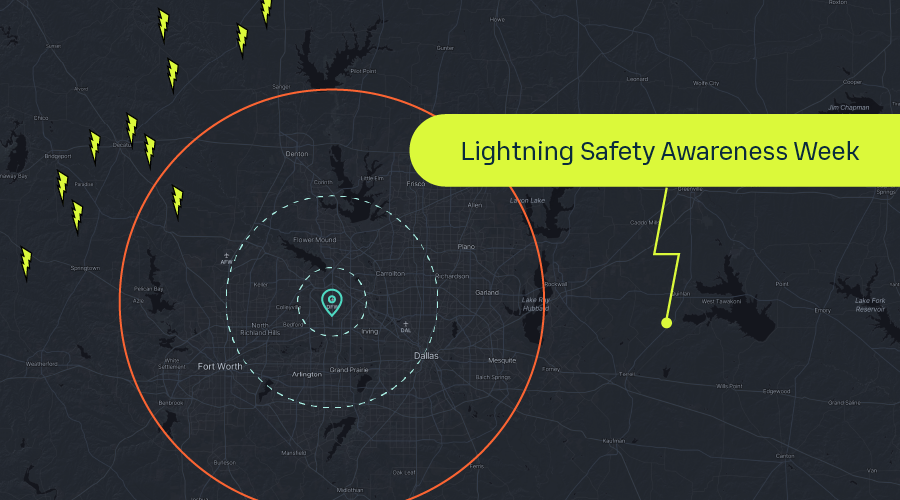Today's best long-range lightning detection network can detect lightning thousands of kilometers away over land and sea with an average locational accuracy of just 1 kilometer, enabling effective operational safety at any location worldwide. The best precision network can detect lightning events with a median location accuracy of just 84 m. That's less than the length of a football field. Incredible!
In this post for Lightning Safety Awareness Week, we'll look at how lightning detection has improved over the years and how businesses can harness this technology to protect their personnel from severe weather risks.
Early innovation
Believe it or not, the first lightning detector was invented over a century ago, in the 1890s. Alexander Popov, a Russian physicist, built a device that sensed the electromagnetic pulses emitted by lightning. For the first time, people could detect lightning beyond the limits of what they could see and hear. Detecting these pulses is still a fundamental part of modern lightning detection systems today.
In the late 1950s, meteorologists began using multiple detection stations and Time of Arrival (TOA) techniques to determine where lightning occurred—another big step forward in lightning safety.
A national network
Researchers continued to improve the technology, and regional lightning detection networks started appearing in the late 1970s. Private, federal, and university groups cooperated to connect and develop these networks into a single nationwide system. In 1983, Global Atmospherics (now Vaisala) in collaboration with the State University of New York at Albany established the U.S. National Lightning Detection Network (NLDN).
With the NLDN, scientists and businesses now had a single source for real-time lightning events anywhere in the contiguous United States. The NLDN greatly improved our ability to track and understand both individual storms and mesoscale convective systems.
Going global
Driven by a vision to detect lightning anywhere in the world, Vaisala launched its long-range global lightning detection network, GLD360, in 2009. While the network's locational accuracy ranged from 5 to 10 kilometers in its early days, it now pinpoints lightning anywhere on Earth to within 1 km on average.
With lightning data from GLD360, companies could now put effective lightning safety measures into place at any location worldwide. Demonstrating its reach, GLD360 detected lightning just 52 kilometers from the North Pole in August 2019, the northernmost lightning strike ever recorded.
Modern capabilities
Vaisala has been developing its lightning detection technology for over 40 years. Today, our NLDN and GLD360 lightning detection networks provide the world's most consistently accurate and reliable lightning data, detecting 99.9% of thunderstorms worldwide and recording more than two billion lightning events in real-time every year. This is 5–10 times more than any other network or technology.
To enhance safety, our lightning detection networks can distinguish between in-cloud pulses and cloud-to-ground strokes. We can even identify the lightning strokes with the highest potential to cause damage and start fires. Using machine learning, our Xcast technology delivers lightning forecasts for at-risk areas up to 60 minutes in advance.
Lightning data for severe weather safety
Vaisala Xweather helps you understand and manage the risks from lightning and other extreme weather events with forecasts, warnings, and alerts to protect your people, property, and infrastructure.
Businesses use historical lightning density data to assess sites for new wind farms, industrial facilities, logistics depots, and more. Historical lightning data helps companies understand and manage the risk and financial impact of lightning during construction and operation.
However, historical lightning data alone isn't sufficient for managing daily operations. In industries where downtime costs thousands of dollars a minute, access to real-time lightning data is crucial for minimizing disruptions.
Xweather provides real-time information about approaching thunderstorms to enhance situational awareness and understanding of severe weather impacts. Automated lightning alerts and all-clear notifications enable companies to keep workers safe while minimizing downtime and false alarms.
Improve your worksite safety today
Vaisala Xweather offers reliable, single-source access to real-time and historical lightning data to meet the needs of a range of industries from energy, aviation, and defense, to maritime, construction, and insurance. The National Weather Service, the Federal Aviation Administration, the U.S. Air Force and Navy, and many others rely on lightning data from Vaisala Xweather.
The Xweather API puts global lightning data at your fingertips. From historical lightning data to real-time strike detection and forecasting, our lightning API endpoints and mapping layers are ready to power your weather-sensitive applications and solutions today.
Xweather Protect offers comprehensive weather risk management, real-time storm tracking, and automated lightning alerts for all your locations worldwide.
Check out our other resources during Lightning Safety Awareness Week for more tips and insights.



